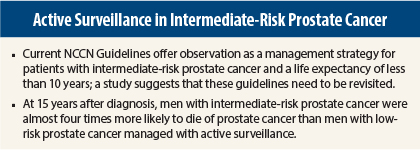A study presented at the 2015 Genitourinary Cancers Symposium calls into question the use of active surveillance in patients with intermediate-risk prostate cancer. Patients with intermediate-risk prostate cancer managed with active surveillance had almost a four times higher risk of prostate cancer–specific death over 15 years compared with low-risk prostate cancer managed with active surveillance.1 This single-center study is the first to analyze long-term outcomes of patients with intermediate-risk prostate cancer on active surveillance.
Surprising Finding
The current National Comprehensive Cancer Network (NCCN) Guidelines call for observation (ie, active surveillance) or radiation therapy with or without androgen-deprivation therapy for 4 to 6 months for men with intermediate-risk prostate cancer and a life expectancy of less than 10 years. The current study suggests that these guidelines should be reconsidered.
“This study validates active surveillance for low-risk patients with prostate cancer. We were surprised by the greater risk of prostate cancer death in the intermediate-risk patients assigned to active surveillance,” stated senior author D. Andrew Loblaw, MD, Sunnybrook Health Sciences Center in Toronto.
“Caution should be exercised if active surveillance were to be implemented for intermediate-risk patients,” stated lead author Hima Bindu Musunuru, MD, also of Sunnybrook Health
Sciences Center.
Study Details
The prospective study included 945 patients managed with active surveillance between 1995 and 2013 at Sunnybrook Health Sciences Center: 237 (23.9%) with intermediate-risk and a median follow-up of 6.9 years and 708 with low-risk prostate cancer and a median follow-up of 6.4 years. The median treatment-free interval for intermediate-risk patients was 12.3 years.
Patients with progressive disease, reflected by a prostate-specific antigen (PSA) doubling time of less than 3 years, were offered radiation or surgery; 86 intermediate-risk patients took advantage of this treatment (mainly radiation, Dr. Loblaw noted).
For intermediate-risk patients, 10-year and 15-year overall survival rates were 68.4% and 50.3% vs 83.6% and 68.8% for low-risk patients (P < .0001). The 10- and 15-year cancer-specific survival rates were 95.5% and 88.5% for the intermediate-risk cohort, and 98.2% and 96.3% for the low-risk patients (P = .006).
Dr. Loblaw reported that 61% of the intermediate-risk patients were older than age 70. He noted that active surveillance is typically offered to men with shorter life expectancies and other comorbidities.
The risk for dying of any cause was twice as high for intermediate-risk patients compared with low-risk patients, reflecting the selection of intermediate-risk patients with lower life expectancy. Further, the risk of prostate cancer–specific death at 15 years was 3.75 times higher for intermediate-risk patients compared with low-risk patients at the same time point: 11.5% vs 3.7%, respectively.
The subcategorization of intermediate-risk patients according to molecular and/or clinical markers is an ongoing area of study, said Charles Ryan, MD, ASCO Expert and GU News Planning Team Member. He served as moderator of a premeeting presscast where these data were presented.
Dr. Loblaw agreed that the categorization of intermediate-risk patients needs to be further refined. “We think there may be a subgroup of intermediate-risk patients out there who may be safely managed by active surveillance,” he commented.
Favorable vs Unfavorable Intermediate Risk
Intermediate-risk patients are a heterogeneous group of patients. Zumsteg and colleagues have proposed a new risk classification system for therapeutic decision-making for intermediate-risk patients undergoing external-beam radiotherapy.2 They defined favorable intermediate risk as a Gleason score of 3+4 or less, a percentage of positive biopsy cores less than 50%, and, at most, one National Comprehensive Cancer Network (NCCN) determinant of intermediate-risk prostate cancer. The criteria proposed by Zumsteg et al have not been incorporated into official guidelines.
Weighing in on the question of whether there may be some intermediate-risk patients who can be safely managed with active surveillance, Jason A. Efstathiou, MD, DPhil, Associate Professor of Radiation Oncology at Massachusetts General Hospital, Harvard Medical School, in Boston, said that management of intermediate-risk patients must be tailored to the individual.
“Not all intermediate-risk patients are the same. For example, a patient with 12/12 positive cores, Gleason score of 4+3, and a PSA of 19.9 ng/mL is not the same as an intermediate-risk patient with < 5% of 1 core involved, Gleason score 3+4, and PSA of 5 ng/mL. Intermediate risk is a spectrum. Some investigators have attempted to stratify intermediate risk based on T stage, Gleason score, percent of cores involved, percent of each core involved, and PSA level,” Dr. Efstathiou said.
“There are some intermediate-risk patients who may be appropriate candidates for active surveillance, especially if they have a more limited life expectancy due to age or comorbidities. That being said, intermediate-risk prostate cancer can progress, and the majority of these patients do need definitive therapy aimed with curative intent,” he continued.
This prospective study by Loblaw and colleagues will need prospective validation, and there are ongoing trials addressing this question, he noted.
PROTECT Trial
The PROTECT trial, which randomly assigned 250,000 men to PSA screening or not, may provide some clues. The screening arm will be stratified according to low and intermediate risk, and patients will be randomized to receive radical prostatectomy, external-beam radiation with or without androgen-deprivation therapy, or active surveillance.
Dr. Efstathiou noted that the availability of genomic and other biomarkers would be ideal in this setting, but in his opinion, a number of standard markers are already available to risk-stratify intermediate-risk patients. These include age, comorbidities, life expectancy, stage, grade, number of cores involved, percentage of cores involved, and PSA level. In addition, he said that advances in imaging, such as multiparametric endorectal magnetic resonance imaging, can help determine disease volume and potentially aggressiveness, especially in areas of the prostate not accessible by the biopsy needle.
“The totality of data from these clinical factors and assessments can give us a good idea of which intermediate-risk patients are of more favorable risk and which are not,” he stated. ■
Disclosure: Dr. Loblaw reported receiving honoraria from Amgen, Astellas Pharma, AstraZeneca, and Sanofi, a consulting or advisory role with Amgen, Astellas Pharma, Janssen Oncology, and Sanofi, research funding (to his institution) from Paladin and Sanofi, and support for travel, accommodations, and expenses from Amgen, Janssen Oncology, and Paladin. In addition, he reported honoraria and/or a consulting/advisory role for an immediate family member from Bristol-Myers Squibb, Elekta, GlaxoSmithKline, Jannssen Oncology, Merck, Novartis, Paladin, Roche, Sanofi. The other study authors reported no potential conflicts of interest.
References
1. Musunuru HB, Klotz L, Vespirini D, et al: Cautionary tale of active surveillance in intermediate-risk patients: Overall and cause-specific survival in the Sunnybrook experience. 2015 Genitourinary Cancers Symposium. Abstract 163. Presented February 26, 2015.
2. Zumsteg ZS, Spratt DE, Pei I, et al: A new risk classification system for therapeutic decision making with intermediate-risk prostate cancer patients undergoing dose-escalated external beam radiation therapy. Eur Urol 64:895-902, 2013.





